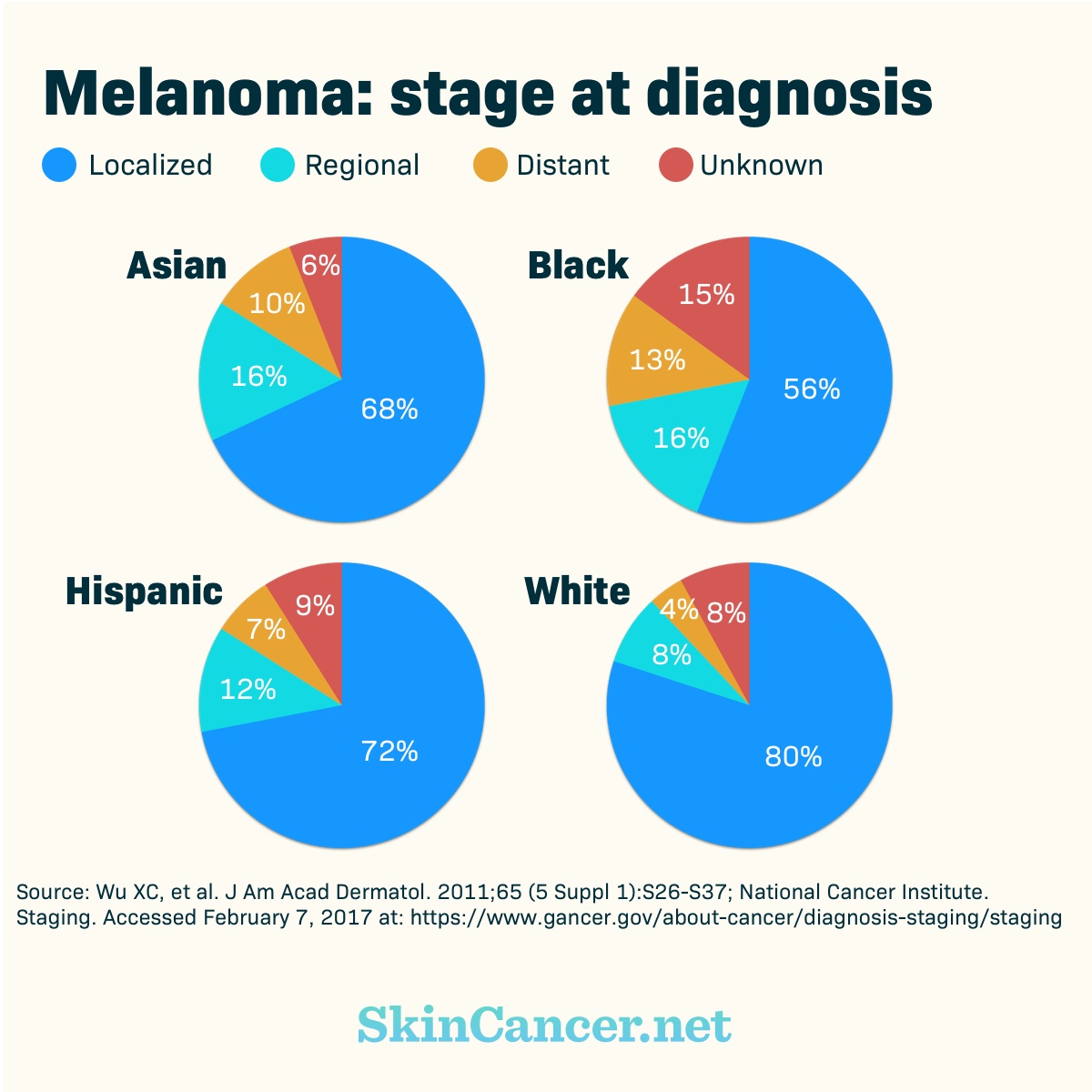Skin Cancer in People with Dark Skin Tones
Reviewed by: HU Medical Review Board | Last reviewed: May 2017. | Last updated: April 2022
People with dark skin tones are at risk for developing skin cancer. Skin cancer may be less common than in white persons, but it can be more dangerous. People with dark skin tones are often diagnosed at a later stage. Late-stage skin cancer is harder to cure.
Risk factors: Everyone is at risk
Studies have shown that even at low levels, ultraviolet (UV) radiation damages all types of skin.1Melanin is a pigment that gives skin its tan or brown color. Darker skin has larger, more productive melanocytes.1 Melanin protects skin from UV radiation. Dark skin recovers from UV damage more quickly than light skin. Nevertheless, no one is immune to UV damage. Sun protection is important for everyone, regardless of skin tone.
Non-UV risk factors contribute to skin cancer in people with dark skin tones.1 These risk factors include:
- Scarring
- Inflammation
- Injury/trauma
- Weakened immune system
- Human papilloma virus (HPV) infection
The risk factors for some skin cancers are unknown. For example, no one knows why some people develop melanoma on parts of the body that rarely get sun.
Delayed diagnosis, worse outcomes
There are three main types of skin cancer: basal cell carcinoma (BCC), squamous cell carcinoma (SCC), and melanoma. Each type can appear in several different ways. Cancerous lesions may look different in people with dark skin tones than they do in white people. For example, BCC is often pink or translucent in fair skinned individuals. In people with dark skin tones, BCC can be pigmented (dark). Lesions that typically develop on sun-exposed skin in white persons may appear in less typical locations in people with dark skin tones.
Because providers and patients may not recognize a lesion as skin cancer, it may take longer to diagnose. Delays mean that skin cancer is diagnosed at a later stage.1-4
Figure 1. Stage at diagnosis by race
Skin cancer in blacks
SCC is the most common skin cancer in blacks.1 People are most likely to be diagnosed in their 40s.1 SCC is most often found on the lower limbs, head, neck, and genitals. SCC may develop in a scar, ulcer, or area affected by a traumatic injury.1 BCC is rare in black Americans, but has been reported in other black populations.1
About 1.1 per 100,000 black Americans is diagnosed with melanoma.5 The most common type is acral lentiginous melanoma.6 Acral lentiginous melanoma is not related to sun exposure. This type of melanoma develops on palms, soles, joints, and nails.7,8 The lesion is usually black or brown, but can be colorless, as well. It may be mistaken for a bruise that does not go away.
Among black Americans with melanoma, about half have local melanoma. The 5-year survival rate for local melanoma is 90%.2 About one quarter (26%) of melanoma is diagnosed after it has spread to nearby lymph nodes. The 5-year survival rate for regional melanoma is 46.7%. About 15% of cases are distant metastatic melanoma, which is when cancer has spread to other parts of the body. The 5-year survival rate at this stage is 21.6%.
Skin cancer in Hispanics
BCC is the most common skin cancer in Hispanics.1 In Hispanics, BCC is often pigmented. It may be misdiagnosed as melanoma. These lesions are most likely to appear on the head and neck. SCC is the second most common skin cancer in Hispanics.1
About 4.8 per 100,000 Hispanics are diagnosed with melanoma.5 On average, Hispanics are diagnosed at slightly younger age (52-56 years) compared with blacks and whites (59-63 years).3 The most common type of melanoma is superficial spreading melanoma. Melanoma is likely to grow on the chest, back, lower limbs, and hips.
The 5-year survival rate for Hispanics with local melanoma is 97.3%.3 The 5-year survival rates for regional and distant melanoma are 63.9% and 23.7%.3
Skin cancer in Asians
Non-melanoma skin cancer is uncommon in Asians, but it has been reported. SCC and BCC may be pigmented in Asians, leading to misdiagnosis as melanoma. Melanoma is diagnosed in 1.6 per 100,000 Asians and Pacific Islanders.5 Women are slightly more likely than men to be diagnosed.3 Twenty-two percent of melanomas in Asians are superficial spreading melanoma.3 Melanoma is most likely to develop on the lower limbs and hips.3
The 5-year survival rate for Asians with local melanoma is 95.3%.3 The 5-year survival rates for regional and distant melanoma are 65.5% and 27.5%.3
